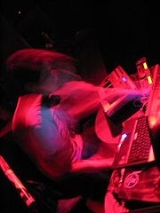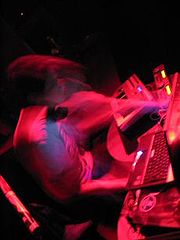
LivePA
Encyclopedia

Electronic music
Electronic music is music that employs electronic musical instruments and electronic music technology in its production. In general a distinction can be made between sound produced using electromechanical means and that produced using electronic technology. Examples of electromechanical sound...
in a concert setting.
While the term "Live PA" literally means "Live Personal Appearance", a legal term originally used to protect promoters when performances are occasionally prerecorded, in common usage it refers to live performance of electronic music, via synthesizers, samplers, and sequencers.
In a performative context, the term was originally used to refer to live appearances, initially at rave events in the late 1980s, of studio based electronic dance music
Electronic dance music
Electronic dance music is electronic music produced primarily for the purposes of use within a nightclub setting, or in an environment that is centered upon dance-based entertainment...
artists. The concept of the Live PA helped provide a public face for a scene that was criticised as faceless by the mainstream music press. The trend was quickly exploited by a music industry desperate to market dance music to a popular audience.
Execution
Performing a Live PA is an open process; there are very few pre-defined rules other than that the resulting sound/music is considered to be "electronic". Execution can range from pushing play on an audio CDRed Book (audio CD standard)
Red Book is the standard for audio CDs . It is named after one of the Rainbow Books, a series of books that contain the technical specifications for all CD and CD-ROM formats.The first edition of the Red Book was released in 1980 by Philips and Sony; it was adopted by the Digital Audio Disc...
while pretending to play instruments, to live keyboard playing alongside a live drummer or percussionist, and anything in between.
Generally Live PA artists use a central sequencer
Music sequencer
The music sequencer is a device or computer software to record, edit, play back the music, by handling note and performance information in several forms, typically :...
which triggers and controls sound generating devices like synthesizers, drum machines, samplers
Sampler (musical instrument)
A sampler is an electronic musical instrument similar in some respects to a synthesizer but, instead of generating sounds, it uses recordings of sounds that are loaded or recorded into it by the user and then played back by means of a keyboard, sequencer or other triggering device to perform or...
. The resulting audio outputs of these devices are then mixed and modified with effects using a mixing console
Mixing console
In professional audio, a mixing console, or audio mixer, also called a sound board, mixing desk, or mixer is an electronic device for combining , routing, and changing the level, timbre and/or dynamics of audio signals. A mixer can mix analog or digital signals, depending on the type of mixer...
. Interconnected drum machines and synthesizers allow the electronic Live PA artist to effectively orchestrate a single-person concert. Hand-played keyboards, hand-triggered audio samples, live vocals, and other live instruments can augment the performance as well. Some artists like Brian Transeau and Jamie Lidell
Jamie Lidell
Jamie Lidell is an English musician and soul singer living in Nashville, United States...
utilize hardware and software tools custom-designed for live expression and improvisation.
By arranging, muting, and cueing pre-composed basic musical data (notes, loops, patterns, and sequences), the Live PA artist has the freedom to manipulate major elements of the performance and alter a song's progression in real-time.
Many Live PA artists try to combine the qualities of both traditional bands and dancefloor DJs, taking the live music element from bands, and the buildup and progression from song to song of DJs, as well as the sheer volume of music controlled by a single person (of a DJ as opposed to a band). By allowing the sequencer to handle the playing of basic musical data (as defined above), the Live PA artist can focus on controlling what is most important to the listener: the actual musical quality of what is emanating from the speakers.
From Hardware to Software
Technological progress has kept Live PAs evolving to this day. With advances in computer processing power and in software-based audio tools and instruments, the Live PA artist can pack a single laptop into a bag, go out and perform a show. This possibility creates a point of discussion, as the ability to perform one's own music live using a single, generic device creates yet another range of performative styles. On one end, a laptop-based performer has the option of simply playing a polished, premade audio file. On the other end, the performer can be creating sound completely from scratch using software-based synthesizers, sequencers, etc. Somewhere in the middle is where the majority of performance setups fall. Incredibly popular is the software tool Ableton LiveAbleton Live
Ableton Live is a loop-based software music sequencer and DAW for Mac OS and Windows by Ableton. The latest major release of Live, Version 8, was released in April 2009. In contrast to many other software sequencers, Live is designed to be an instrument for live performances as well as a tool for...
. This gives a laptop-based performing artist the ability to sequence and trigger software synthesizers, external MIDI-controlled instruments, and internally-stored sampled audio clips and loops. This can all be achieved in real-time, with the resulting audio being manipulated by Ableton Live's mixer and effect processors.
The feasibility of using a laptop computer as an all-in-one electronic music creation and performance tool created a massive wave of new artists, performers, and performance events. An international contest known as the Laptop Battle
Laptop battle
Laptop battles are a competitive event for an Electronic musician to match their skills against others. Competition rules limit equipment to a laptop computer and an external pointing device . Some competitions will allow external hardware, usually a single MIDI controller...
has gained massive momentum and is taken very seriously.
Degree of "Liveness"
A topic of discussion amongst listeners, critics, and artists themselves is to what degree a performance is actually "live". A possible determining factor could be the degree to which the performing artist has real-time control over individual elements of the final musical output. Using this criterion, an artist who mimicks the playing of instruments whilst simply playing a CD or stereo audio track, might not be considered particularly "live" by some. On the far opposite end of the spectrum, some artists choose to take only an idea or motif (e.g. a bassline, rhythm pattern, or chord progression), realize it from scratch with electronic instruments on-the-spot, and then build upon it, modify it, and continue in this way for the entire performance. This requires a degree of discipline and creativity to achieve.Some might argue that the visual aspect of a performance would be sufficient to call it "live". Codifying what defines "live" and what does not has been an ongoing topic of debate for many years. To date, nobody has successfully created a definition with which everyone involved seems satisfied.

